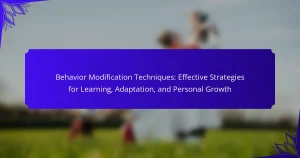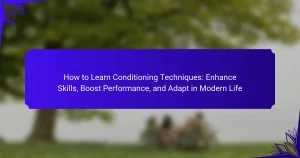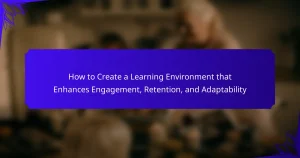Cognitive conditioning methods significantly enhance learning efficiency and retention, addressing common challenges in today’s digital learning environment. Techniques like spaced repetition and active recall improve information processing and memory recall. Unique strategies such as gamification and dual coding further boost engagement and retention rates. Best practices, including setting clear goals and providing feedback, are essential for effective implementation.
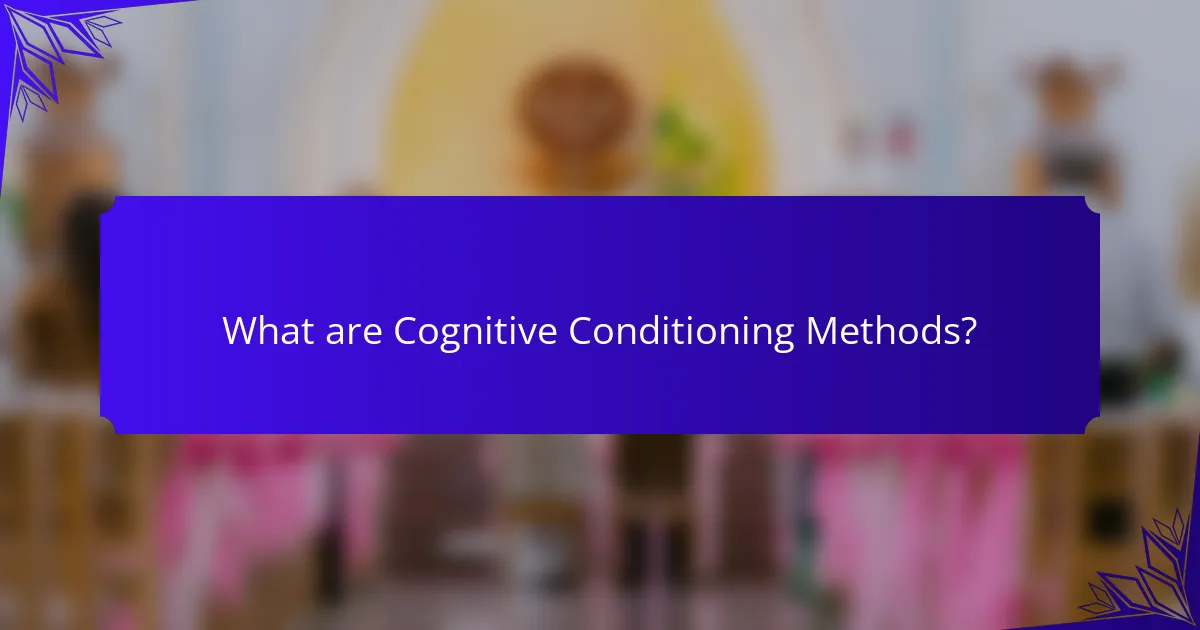
What are Cognitive Conditioning Methods?
Cognitive conditioning methods are strategies that enhance learning efficiency and retention. These methods leverage psychological principles to improve information processing and memory recall. Techniques such as spaced repetition, active recall, and associative learning are effective in today’s digital age. Research shows that incorporating these methods can significantly boost retention rates by up to 50%.
How do Cognitive Conditioning Methods fit into Modern Learning?
Cognitive conditioning methods significantly enhance learning efficiency and retention in today’s digital age. These techniques, such as spaced repetition and positive reinforcement, adapt to individual learning styles, making education more personalised. Research shows that incorporating these methods can improve information recall by up to 50%. Additionally, cognitive conditioning fosters deeper engagement, leading to a more profound understanding of material. As a result, learners are better equipped to navigate complex information in a fast-paced digital environment.
What are the core principles of Cognitive Conditioning?
Cognitive conditioning enhances learning through principles like reinforcement, association, and cognitive flexibility. These methods promote effective retention and adaptability in information processing. Reinforcement strengthens desired behaviours, while association links new information to existing knowledge. Cognitive flexibility allows learners to apply concepts across various contexts, improving problem-solving skills. Together, these principles create a robust framework for maximising learning efficiency in today’s digital age.

What are the Universal Benefits of Cognitive Conditioning?
Cognitive conditioning enhances learning efficiency and retention by improving focus, memory, and adaptability. Key benefits include increased information retention, better problem-solving skills, and enhanced cognitive flexibility. These methods utilise techniques like spaced repetition and active recall, which are proven to boost long-term memory retention by up to 50%. Additionally, cognitive conditioning fosters a growth mindset, encouraging learners to embrace challenges and persist through difficulties. As a result, individuals experience not only academic improvements but also greater confidence in their cognitive abilities.
How does Cognitive Conditioning improve learning efficiency?
Cognitive conditioning significantly enhances learning efficiency by reinforcing desired behaviours through repeated practice and feedback. This method leverages techniques such as spaced repetition and positive reinforcement to improve retention and understanding. As a result, learners can assimilate information more effectively in today’s digital landscape. Cognitive conditioning also adapts to individual learning styles, making it a unique approach to personalised education.
What impact does Cognitive Conditioning have on information retention?
Cognitive conditioning significantly enhances information retention by reinforcing learning through repetition and association. Techniques such as spaced repetition and mnemonic devices create stronger memory pathways. Research shows that students using these methods retain up to 50% more information compared to traditional study techniques. This approach tailors learning to individual cognitive styles, maximising efficiency in a digital environment.
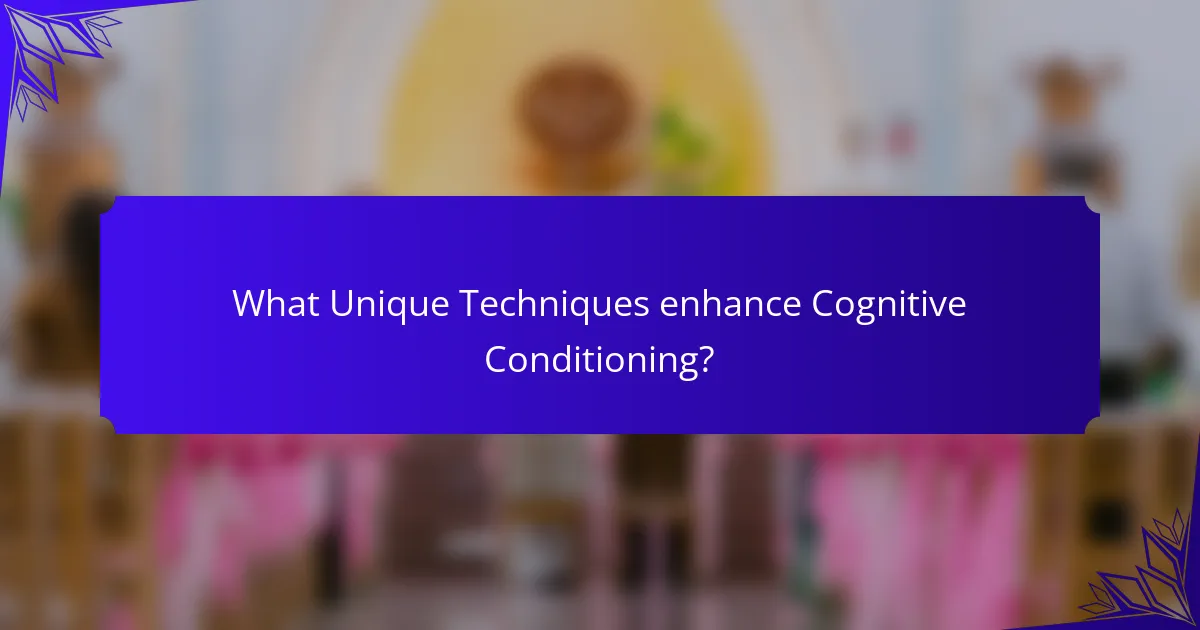
What Unique Techniques enhance Cognitive Conditioning?
Cognitive conditioning can be enhanced through unique techniques like gamification, mindfulness practices, and spaced repetition. These methods improve engagement and retention by creating interactive and focused learning experiences. Gamification incorporates game elements to motivate learners; mindfulness enhances concentration and reduces distractions; spaced repetition leverages timing to optimise memory retention.
How do gamification strategies contribute to Cognitive Conditioning?
Gamification strategies significantly enhance cognitive conditioning by increasing engagement and motivation in learners. These strategies incorporate game-like elements, such as rewards and challenges, which facilitate active participation and reinforce learning behaviours. As a result, learners experience improved retention and understanding of concepts. Unique attributes of gamification include immediate feedback and goal-setting, which are essential for effective cognitive conditioning. By integrating these elements, educational platforms can create an immersive learning environment that promotes sustained attention and enhances memory recall.
What role does technology play in modern Cognitive Conditioning methods?
Technology significantly enhances modern cognitive conditioning methods by providing interactive and adaptive learning experiences. Digital tools, such as apps and online platforms, facilitate personalised training, enabling users to engage at their own pace. These platforms often incorporate gamification, which boosts motivation and retention. Furthermore, data analytics allows for real-time feedback, helping learners identify strengths and weaknesses. This integration of technology not only streamlines the learning process but also fosters a more engaging and effective environment for cognitive conditioning.

What are Rare but Effective Cognitive Conditioning Practices?
Cognitive conditioning practices that are rare yet effective include techniques like dual coding, spaced repetition, and interleaving. These methods enhance learning efficiency and retention by utilising unique cognitive strategies.
Dual coding combines verbal and visual information, improving memory retention through multiple channels. Spaced repetition leverages the spacing effect to reinforce learning over time, enhancing long-term retention. Interleaving mixes different topics or skills during study sessions, promoting better problem-solving and adaptability.
Research indicates that these practices yield superior results compared to traditional methods. For instance, spaced repetition can increase retention rates by up to 50%. By integrating these rare practices, learners can significantly boost their cognitive conditioning and overall learning outcomes.
How can mindfulness be integrated into Cognitive Conditioning?
Mindfulness can enhance cognitive conditioning by improving focus and retention. Integrating mindfulness techniques, such as meditation and breathing exercises, fosters a calm mental state, which aids in better information processing. This practice allows learners to be more present, reducing distractions and enhancing their ability to absorb and retain knowledge. Additionally, mindfulness encourages self-awareness, enabling individuals to recognise when they are struggling with cognitive tasks and adjust their approach accordingly.
What unconventional methods have shown success in Cognitive Conditioning?
Cognitive conditioning has benefited from unconventional methods like gamification, mindfulness practices, and neurofeedback. Gamification increases engagement through game-like elements, enhancing motivation and retention. Mindfulness practices improve focus and cognitive flexibility, leading to better learning outcomes. Neurofeedback trains individuals to regulate brain activity, promoting optimal cognitive function.

What are the Challenges in Implementing Cognitive Conditioning?
Implementing cognitive conditioning faces several challenges, including resistance to change, resource allocation, and maintaining engagement. Resistance often stems from entrenched learning habits that hinder the adoption of new methods. Resource allocation is critical, as effective cognitive conditioning requires time, technology, and training. Maintaining engagement presents a unique challenge; learners may lose interest without ongoing motivation and relevant content. These factors collectively impact the effectiveness of cognitive conditioning methods in enhancing learning efficiency and retention.
What common misconceptions exist about Cognitive Conditioning?
Cognitive conditioning is often misunderstood as merely rote memorisation or simplistic behaviour modification. Many believe it lacks depth in fostering critical thinking or creativity. In reality, cognitive conditioning enhances learning efficiency by promoting adaptive thinking and retention strategies tailored to individual needs. Another misconception is that it is only applicable in educational settings; however, its principles can significantly benefit personal development and workplace training. Understanding these nuances helps in effectively applying cognitive conditioning methods.
How can learners overcome barriers to effective Cognitive Conditioning?
Learners can overcome barriers to effective Cognitive Conditioning by employing targeted strategies. First, they should identify specific obstacles such as lack of motivation or distractions. Next, they can create a structured study environment that minimises interruptions. Utilising technology, such as apps for focus and time management, enhances efficiency. Additionally, incorporating varied learning methods, like visual aids and interactive exercises, fosters retention. Finally, regular self-assessment helps track progress and adjust techniques as needed.
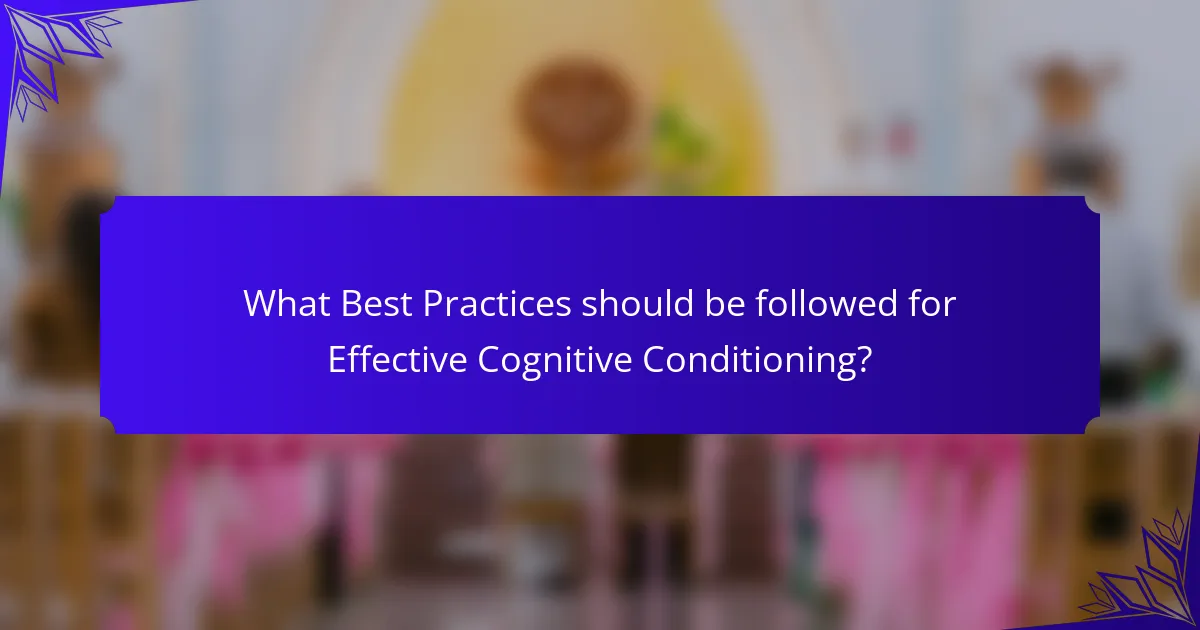
What Best Practices should be followed for Effective Cognitive Conditioning?
To achieve effective cognitive conditioning, follow these best practices: establish clear goals, utilise varied learning methods, incorporate regular feedback, and promote a growth mindset. These practices enhance learning efficiency and retention in digital environments.
1. Set specific objectives to guide the learning process.
2. Employ diverse techniques such as spaced repetition and active recall.
3. Provide constructive feedback to reinforce understanding.
4. Encourage resilience and adaptability in learners.
What are the top tips for optimising Cognitive Conditioning methods?
To optimise cognitive conditioning methods, focus on active engagement, consistent practice, and personalised feedback. Incorporate techniques like spaced repetition, which enhances retention by revisiting material at strategic intervals. Utilise varied learning formats, such as visual aids and interactive tasks, to cater to different learning styles. Lastly, set clear goals to maintain motivation and track progress effectively.
What common mistakes should be avoided in Cognitive Conditioning?
To enhance cognitive conditioning, avoid common mistakes like neglecting individual learning styles, failing to set clear goals, and overloading information. These errors can hinder retention and efficiency. Additionally, ignoring feedback and skipping practice sessions can diminish the effectiveness of conditioning methods.
How can feedback loops enhance Cognitive Conditioning outcomes?
Feedback loops significantly enhance Cognitive Conditioning outcomes by providing continuous reinforcement and adjustment of learning strategies. They allow learners to receive immediate responses to their actions, facilitating better retention and understanding. This iterative process helps identify effective methods, leading to improved learning efficiency. For instance, regular assessments can inform adjustments in teaching techniques, tailoring them to individual needs. As a result, learners experience a more personalised approach, optimising their cognitive conditioning journey.
